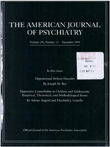Hypnotically induced auditory hallucinations and the mouth-opening maneuver: a failure to duplicate findings
Abstract
OBJECTIVE: The authors sought to replicate the part of a study by Bick and Kinsbourne in which hypnotically induced auditory hallucinations in normal volunteer subjects were abolished by requiring the subjects to open their mouths. METHODS: Sixty-four normal volunteer subjects were hypnotized, and an attempt was made to induce auditory hallucinations. The subjects in whom hallucinations were successfully induced were then asked to perform the mouth-opening maneuver and the control maneuvers of putting their fingers in their ears or squeezing their eyes shut in an effort to end the hallucinations. RESULTS: Sixteen subjects reported having hallucinations. None of them reported that a hallucination was abolished by opening the mouth or closing the eye; four reported ending hallucinations by putting their fingers in their ears. CONCLUSIONS: Opening the mouth does not affect auditory hallucinations induced by hypnosis in normal persons. The most likely reason for the discrepancy between the results of this experiment and those of the Bick and Kinsbourne study is that the design of the latter study was faulty because it permitted demand characteristics to influence the results.
Access content
To read the fulltext, please use one of the options below to sign in or purchase access.- Personal login
- Institutional Login
- Sign in via OpenAthens
- Register for access
-
Please login/register if you wish to pair your device and check access availability.
Not a subscriber?
PsychiatryOnline subscription options offer access to the DSM-5 library, books, journals, CME, and patient resources. This all-in-one virtual library provides psychiatrists and mental health professionals with key resources for diagnosis, treatment, research, and professional development.
Need more help? PsychiatryOnline Customer Service may be reached by emailing [email protected] or by calling 800-368-5777 (in the U.S.) or 703-907-7322 (outside the U.S.).



